Perfect Pan-Seared Duck Breasts with Port Wine Sauce
This post may contain affiliate links. Please read my disclosure policy.
This duck breast recipe comes together so quickly, looks so beautiful, and is so tasty: perfectly crisp skin and flesh medium-rare. The sauce is restaurant caliber. Date night at home? Open a bottle of wine and start cooking!
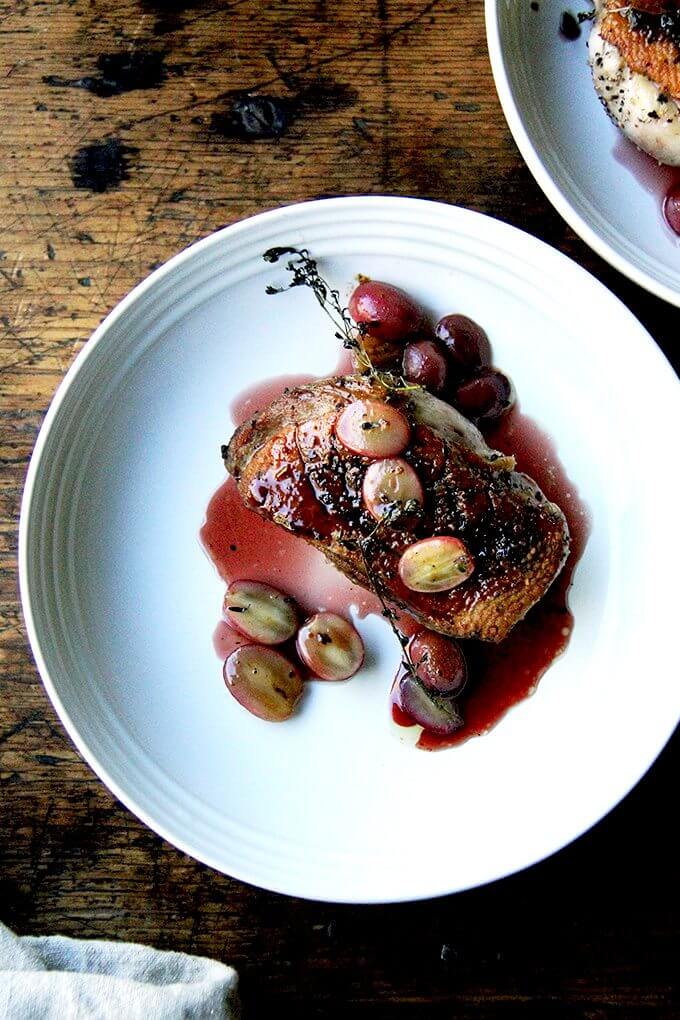
Several weeks ago, I had dinner at Otway in Brooklyn. Chef Claire Welle prepared a fall meal in collaboration with Le Creuset and Cherry Bombe in anticipation of the now-released Le Creuset Cookbook and tableware collection. Of the many memorable dishes Claire cooked for the event, several came from the Le Creuset Cookbook itself, including one of my favorites of the evening: duck breast with banyuls gastrique.
As I swiped each piece of duck through the ruby red sauce pooling on the plate, I remember thinking: Only in a restaurant is duck ever this good, the meat this perfectly cooked, the sauce this flavorful. When I turned to the recipe in the Le Creuset Cookbook, I expected to see a list of elusive ingredients and a note saying: sous-vide machine required.
On the contrary, the recipe looked simple, the sauce requiring three ingredients, the duck an oven-proof skillet. I was intrigued by the technique, too:
“Instead of slapping the duck into a screaming hot skillet, scored breasts are placed skin-side down in a cold pan, slowly brought up to temperature, and left undisturbed until they render copious amounts of delicious fat and the skin turns deep brown and crisp.”
Cold. Pan. Did you catch that?
I’ve now made the dish complete with fancy sauce and thyme-roasted grapes several times, and every time I am surprised by how quickly it comes together, how impressive it looks, and how tasty it is. I’ve never cooked better duck at home, with skin beautifully crisp, flesh medium rare, the sauce restaurant caliber. What’s more? It turns out the secret to perfectly cooked duck at home is also the key to not smoking out your house. Win win.
What is a Gastrique?
In short: it’s a delicious Port wine sauce. Moreover: it’s nothing to be intimidated by.
If you’ve made a caramel sauce — and even if you haven’t — you can make a gastrique. Here’s the basic process:
- Melt sugar with water in a small saucepan, and cook it until it turns pale gold.
- Add vinegar (Banyuls, if you can find it, red wine, if you cannot).
- Add fortified wine (Banyuls, if you can find it, Ruby Port, if you cannot.)
- Simmer until the sauce reduces to a consistency that will coat the back of a spoon.
As the sauce simmers, it reduces into an irresistibly sweet-sharp syrup, tasting like an expensive aged vinegar. In the end, you will feel you have a pot of gold on your hands, a sauce to make anything better.
With the sauce done, there is nothing tricky about the dish. When the breasts are finished cooking, they, like all meat, must rest, at which point you throw a handful of grapes and a few sprigs of thyme into the now-empty pan and then toss the pan into the oven. Genius! Just the distraction you need to keep you from slicing the duck prematurely.
Duck is rich, like steak, so I’ve been serving the breasts with a simple green salad dressed with a shallot vinaigrette and bread, of course. This meal is dinner-party worthy though weeknight (if you like to do it up) friendly — if you make the sauce ahead of time, the meal comes together in about 20 minutes.
How to Make a Gastrique (Port Wine Sauce)
- Gather your ingredients: sugar, vinegar, Ruby port or Banyuls:
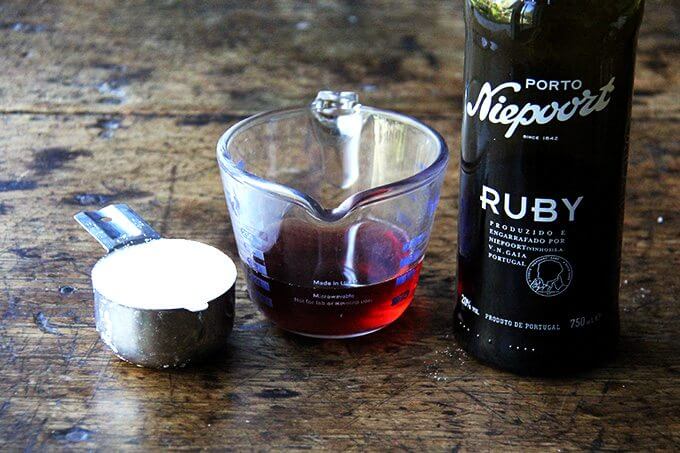
2. Caramelize the sugar:

3. Add the vinegar, at which point, the sugar will harden, and you will feel you are doing it all wrong…
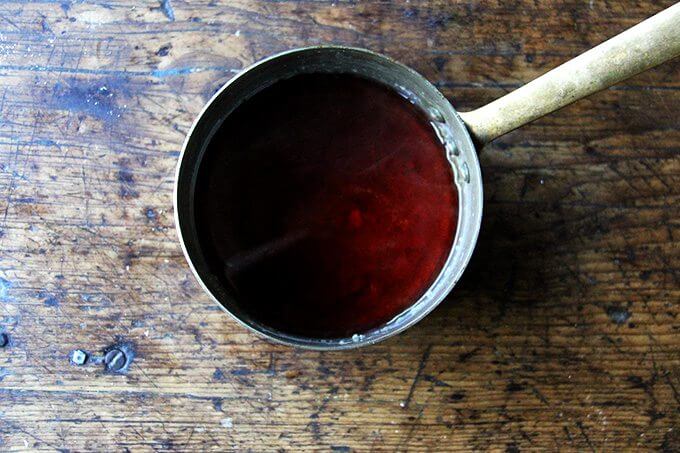
4. …but after a brief simmer, the sugar will melt, you’ll add the Port or Banyuls and simmer for 10 more minutes, at which point the sauce will begin coating the back of a spoon, a sign you have a most delicious, sweet-sharp syrup in the house… woot woot!
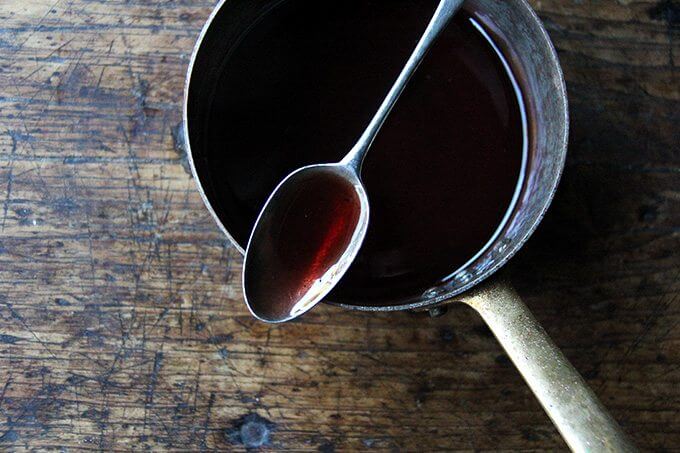
How to Make Perfect Pan-Seared Duck Breasts
- Score four duck breasts.

2. Place them in a cold skillet. (This, by the way, is my new favorite pan. It’s 5 qts, which is to say it can fit a lot of food at one time. Moreover, it distributes heat evenly, it cleans like a dream, it’s oven-safe, and it’s nice to look at to boot. Seen previously here and here.)
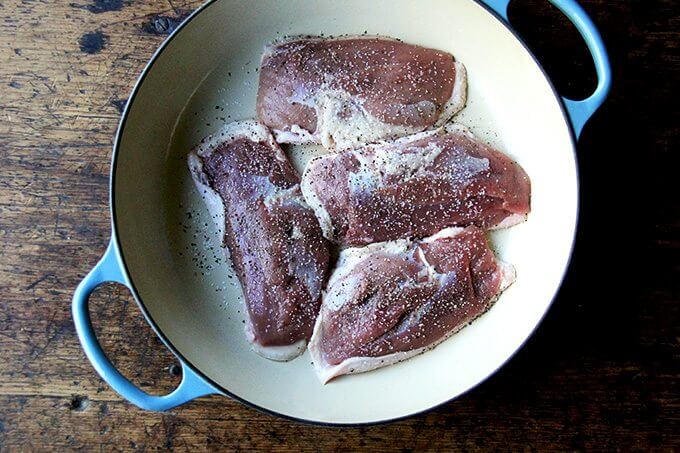
3. Render the fat, then cook until…
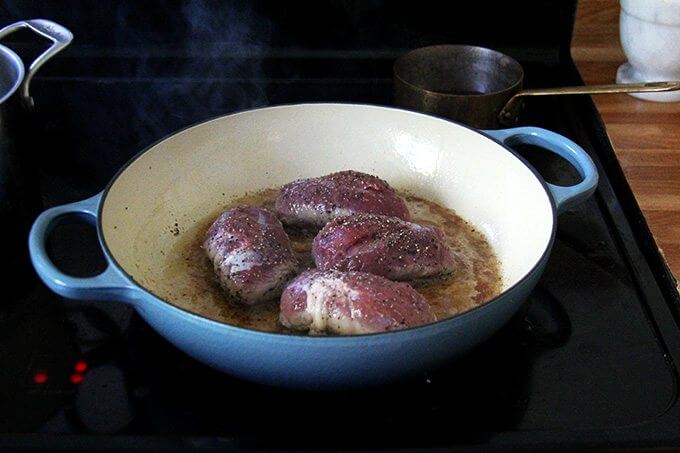
4. … the skin is crisp and in instant-read thermometer — can’t say enough about my Thermapen — registers around 130ºF for medium rare. Transfer duck breasts to a plate to rest.

5. Add grapes and thyme to the pan and roast while the duck rests.

6. Spoon grapes and gastrique over breasts, then …
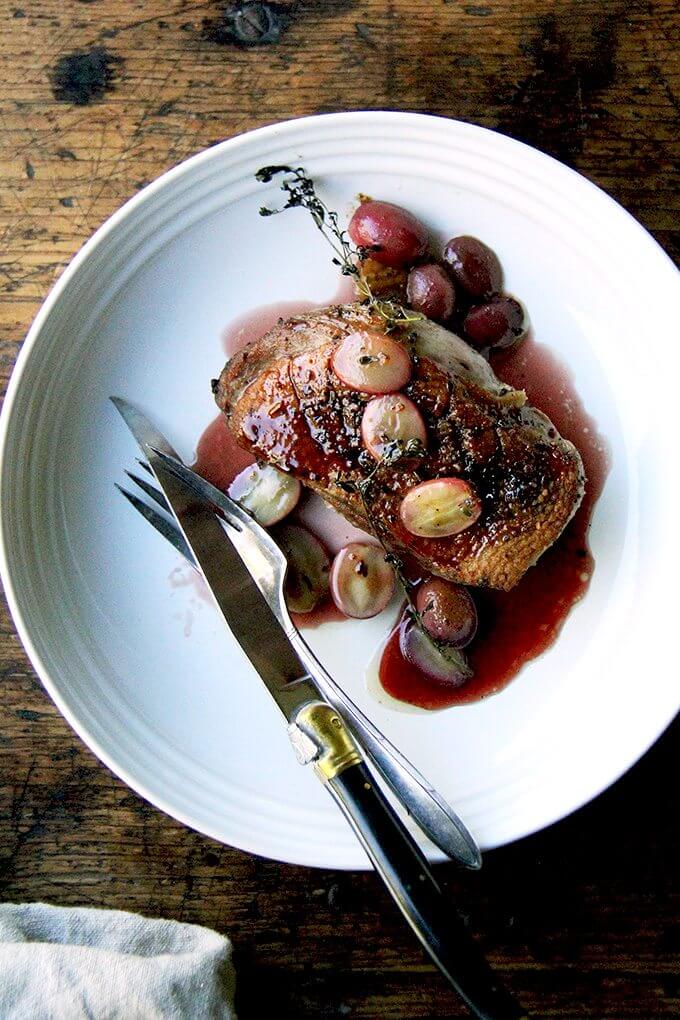
… gather your favorite people around the table.
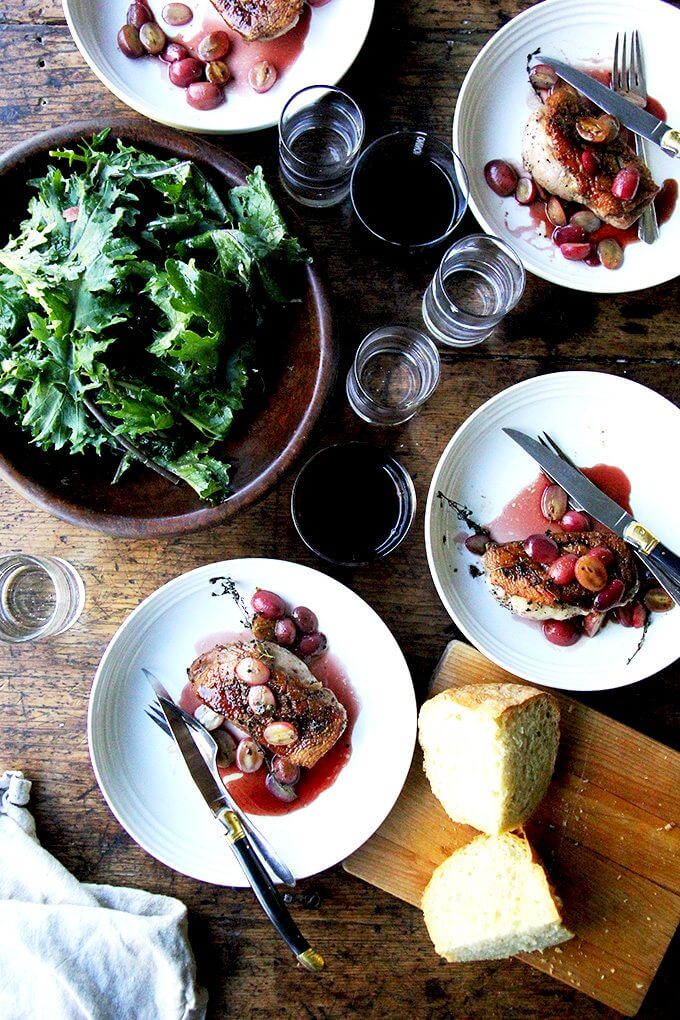
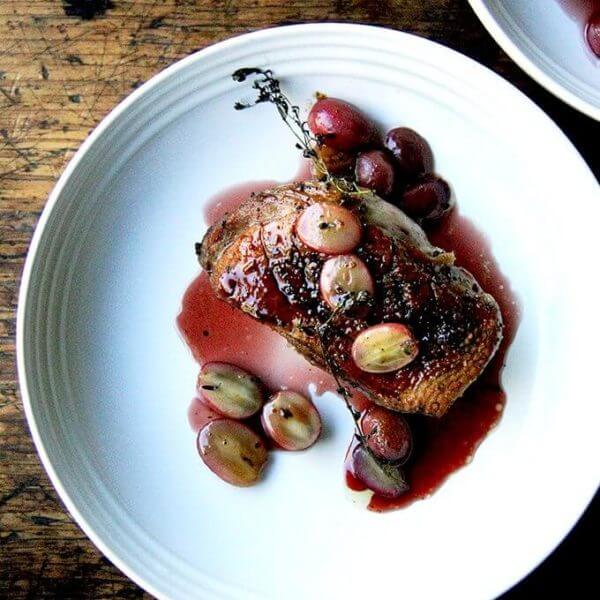
Perfect Pan-Seared Duck Breast with Roasted Grapes & Gastrique
- Total Time: 1 hour
- Yield: Serves 4
Description
Adapted from the Le Creuset cookbook (pronounced l’uh • cru • say)
A few notes:
This summer I invested in a good instant-read thermometer: a Thermapen. I can’t recommend this tool enough. Duck breasts in particular have been a challenge for me to cook — so many times I’ve pulled them from the heat, let them rest, only to cut into them to find flesh too rare or way overcooked. What is hard about cooking meat like steaks or duck breast is that when you get that good sear, it’s misleading — the meat may feel firm to the touch, but you might only be feeling your nice sear … what lies beneath is a guess. The Thermapen takes the guesswork out.
I do not use the star anise, because the first time I made this, I didn’t have any on hand, and I absolutely loved the flavor of the sauce as it was, so I’ve since omitted it. I imagine a single star anise would impart a very nice, subtle spice to the sauce, so absolutely use it if you have one on hand.
Finally, if you have a hard time finding duck, D’artagnan is a great source. I’ve sampled all of the duck varieties they sell. The Muscovy is the tastiest. It’s pricey, but if you think about what it costs to eat duck breast out at a restaurant, it’s not so bad.
Ingredients
- 1/2 cup sugar
- 2 tablespoons water
- 1/2 cup Banylus vinegar or red wine vinegar
- 1/4 cup Banylus fortified wine or ruby port
- 1 star anise pod, optional
- 4 boneless duck breast halves with skin
- kosher salt to taste
- fresh cracked black pepper to taste
- 1.5 cups halved red seedless grapes
- 1 teaspoon chopped fresh thyme (or a few sprigs if you are lazy)
- 1 cup loosely packed mâche or watercress leaves, optional
Instructions
For the gastrique:
- In a small saucepan over medium-high heat, cook the sugar and water, swirling gently until the sugar dissolves and the mixture turns a pale golden color, 8 to 10 minutes. Lift the pan from the heat and pour in the vinegar. The caramel will bubble vigorously and possibly seize and harden. Return the pan to the heat and cook until the caramel is melted and smooth, 2 to 3 minutes. Add the wine and star anise, if using. Simmer until the liquid reduces to thin syrup, about 10 minutes. Discard the star anise. Keep the gastrique warm over very low heat until ready to use.
For the duck breasts:
- Blot the duck breasts dry. Use a sharp knife to score the fat of each in a diamond pattern, taking care not to cut into the meat. Season both sides of each breast generously with salt and pepper, then place them skin side down in a large, cold skillet. Place the skillet over low heat and cook for 3 minutes. Increase the heat to medium, and continue cooking until the duck begins to sizzle. Continue cooking undisturbed until the skin is browned, crisp, and has rendered most of its fat, 6 to 8 minutes.
- Heat oven to 350ºF.
- Spoon off and reserve the fat from the skillet. Flip over the breasts and transfer the skillet to the oven. Alternatively, flip the breast and cook stovetop until the breast registers 125ºF-130ºF. I prefer finishing the breasts stovetop as I feel I have more control/vision on when the breasts look done, at which point I test with my instant-read thermometer. For me it’s been about 2 minutes on the second side. If you place pan in oven, roast for 2 to 4 minutes or until an instant-read thermometer inserted into the thickest part of the breast registers 125ºF-135ºF — Note: I find 125ºF-130ºF to be about right for medium rare. Transfer breasts to a plate to rest.
- Add the grapes to the skillet and toss with the thyme and a pinch of salt and pepper. Roast in the oven until the grapes are hot and wrinkled in spots, 8 to 10 minutes.
- Transfer breasts to plate, spoon grapes over top. Spoon sauce over top. Top with a small handful of mâche, if using, and serve immediately.
- Prep Time: 20 minutes
- Cook Time: 40 minutes
- Category: Dinner
- Method: stovetop
- Cuisine: French
This post may contain affiliate links. Please read my disclosure policy.




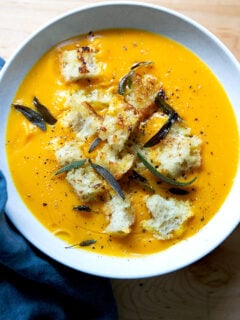
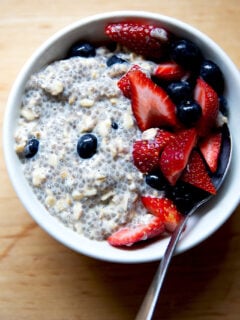
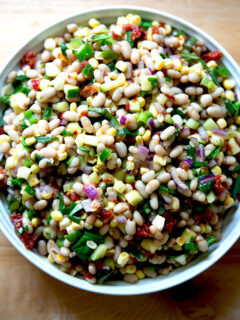





365 Comments on “Perfect Pan-Seared Duck Breasts with Port Wine Sauce”
Based on others’ comments, I reduced the sugar by half, and it was still plenty sweet. I also used dry Amontillado sherry, because I had that and did not have port. The sauce was delicious!
The cooking instructions were so good! I’d made duck before, but without much success. This came out perfect with the cooktop method! My husband said he thought he didn’t like duck, and was happy to find out he did.
So great to hear this, Karen! Glad the husband approved, too 🙂 Thanks for writing.
Hello!
What sides do you typically serve with this dish?I thought in the pictures it looks like a salad but I was not sure and wanted some ideas.
Thank you!
Hi Ale! I do love a simple green salad here with a shallot vinaigrette. But this is another favorite salad as is this one to serve aside the duck. Here are ALL the salads 🙂
We serve it with an unseasoned wild rice blend and a green vegetable, usually asparagus. The wild rice really complements the duck and sauce. A favorite holiday dinner!
So great to hear this, Carol! Wild rice sounds lovely. Thanks for writing and happy New Year!
The duck was great but the reduction caramelized as soon as I put it on the plate. What a chore to clean those pots and dishes. What did I do wrong?
Oh darn! Sorry to hear this, Jeff.
You likely just reduced the sauce a teensy bit too long. Next time (if you are up for making it again), err on the side of under reducing it. You might have to remove the pan from the burner entirely, too, to help encourage the sauce to stop cooking.
I’m sorry about the pots and dishes 😩
Excellent. I made it for my wife’s birthday last year and she wants me to make it again this year, which I’m doing
Great to hear, Richard! Thanks for writing. Happy Birthday to your wife!
When you say spoon off and reserve the fat from the skillet, there’s no indication in the recipe what one does with this reserved fat.can you clarify please
Great question… I just looked at my Le Creuset cookbook, and they instruct you to reserve the fat and save it for another use/other recipes. I have never done this. If you think the fat is salvable, go for it. Otherwise, I would simply discard it.
This is the only duck breast recipe that I may ever make again………. simply fabulous! I made everything on the stovetop. I substituted red wine vinegar that I make from our leftover red wine. I used red wine instead of the ruby port. I used fresh cherries, halved, instead of grapes. Delicious! Thank you!
Wonderful to hear this, Denise! Thanks so much for writing and sharing your notes 🙂 🙂 🙂
I can let you duck lovers know one classic use for duck fat is English roasted potatoes… for extra fun, read Stanley Tucci’s description of them being made … and his family retreating from the kitchen in fear something dangerous was going on. ( in his book “Taste”. Recipe included
The duck came out perfectly but I took my eye off the ball with the sauce and at first it didn’t seem to reduce down .Then suddenly it reduced right down to a teaspoonful of very sticky goo at the bottom of the pan.
Still all in all a very successful dish and will make again
Thanks Alexander!
I’ve been there, Ray! Bummer to hear about the sauce because it kind of feels like gold. I’m likely too late here, but you may be able to salvage it by pouring in more port and heating it very gently, then whisking to emulsify.
An excellent recipe. I’ll definitely make it again, though I’m thinking that dried prunes and/or apricots rehydrated in a bit of warm brandy would be even better than grapes as the fruit element. I’ll try that next time.
I served it with a side of sauteed Swiss chard, which added a welcome note of bitterness to the meal.
Yum to all of this! Love the dried prunes idea. Thanks for writing 🙂
This recipe turned out perfect, exactly as described! I put the duck in the oven to finish is off and the timing in the recipe was precise. I used a cast iron pan for the duck. I went a little more well done (135-140) and it was a med-med well – still very tender and moist. The grapes were a perfect way to sync the salty savoury duck with the sweet port gastrique. I wouldn’t change a thing! I served mine with risotto and a side of grilled asparagus with balsamic reduction and parmesan.
Oh wow, this all sounds fantastic — I love risotto with this sort of thing, and grilled asparagus is a favorite. Thanks for writing and sharing all of your notes.
I was looking for a quick and simple recipe for a duck sauce. Sometimes, getting back to the basics is best. This recipe reminded of the simplicity and deliciousness of a true gastric. Using what i had on hand i made a few modifications and a fabulous sauce that everyone raved about. Instead of the red wine vinegar I used half as much white Balsamic vinegar and in place of the red port wine I used a full bodied Cabernet. For the citrus/fruit i used about 1&1/2 cups of frozen raspberries. The sweetness of the balsamic & the heartiness of the Cabernet were a perfect balance and the thyme really married well with the raspberries. I went super light on the S&P, just a pinch of each. To finish it off I added about 4 tabs of unsalted Irish butter which really added a nice richness & silkiness to the sauce and that really took it over the top.